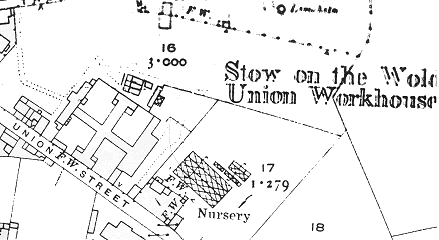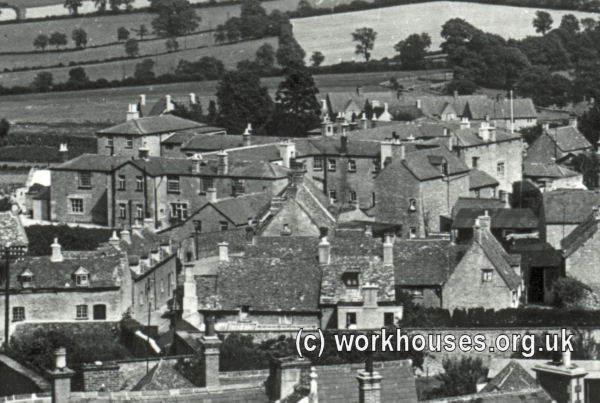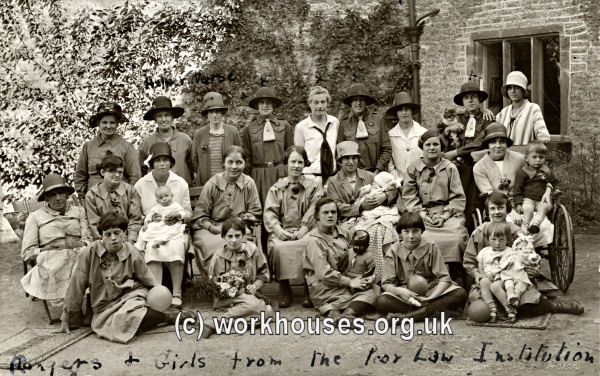Stow-On-The-Wold, Gloucestershire
Up to 1834
A workhouse was in operation in Bourton-on-the-Water by 1783, in a property rented by the parish (Elrington, 1965). The running of it was contracted out from 1787, but its use had ceased by 1803. The parish also made use of the "roundsman system" where ratepayers were obliged to find work for able-bodied paupers with the poor rate contributing to their wages. In the years 1830-33 twelve poor families were assisted in emigrating to North America. In 1834, the Vestry decided to refurbish the building then in use as a poorhouse and to reopen it as a workhouse. A small workhouse was also in use at Bledington.
After 1834
Stow-On-The-Wold Poor Law Union was formed on 25th January 1836. Its operation was overseen by an elected Board of Guardians, 30 in number, representing its 28 constituent parishes as listed below (figures in brackets indicate numbers of Guardians if more than one):
County of Gloucester:
Adlestrop, Great Barrington, Bledington, Bourton-on-the-Water (2), Broadwell, Clapton, Condicote, Donnington, Eyford, Icomb, Church Icomb, Longborough, Maugersbury, Naunton, Notgrove, Oddington, Great Rissington, Little Rissington, Wick Rissington, Sezincote, Lower Slaughter, Upper Slaughter, Stow-on-the-Wold (2), Lower Swell, Upper Swell, Westcote.
County of Worcester:
Daylesford, Evenlode.
The population falling within the union at the 1831 census had been 9,105 with parishes ranging in size from Sezincote (population 51) to Stow itself (1,240). The average annual poor-rate expenditure for the period 1833-5 had been £4,682 or 10s.3d. per head.
The Stow-on-the-Wold union workhouse was built in 1836 at a site to the north-east of the town, on what became known as Union Street. It was designed by George Wilkinson who was also responsible for the workhouses at nearby Northleach, Witney and Chipping Norton. It followed the popular cruciform or "square" layout with an entrance block at the front, behind which lay the four accommodation wings radiating from a central hub, creating four yards for the different classes of pauper (male/female, old/young). The location and layout of the site is shown on the 1919 map bwlow:

Stow-on-the-Wold workhouse site, 1919.

Stow-on-the-Wold workhouse — distant view, 1930s?
© Peter Higginbotham.
By the 1920s, girls at some workhouses joined the Girl Guides. A 1924 picture (below) from Stow on the Wold is captioned "Rangers and Girls from the Institution" (Rangers being the senior branch of the Girl Guides) indicating that there was some kind of involvemeny between the Guides and workhouse girls.

Stow-on-the-Wold workhouse girls and Girl Guide Rangers, 1924.
© Peter Higginbotham.
After 1930, the workhouse became the East View Public Assistance Institution and later an elderly care home. The building has since been demolished and housing now occupies the site.
Staff
Inmates
Records
Note: many repositories impose a closure period of up to 100 years for records identifying individuals. Before travelling a long distance, always check that the records you want to consult will be available.
- Gloucestershire Archives, Clarence Row, Alvin Street, Gloucester GL1 3DW. Holdings include: Guardians' minute books (1836-99, 1903-15, 1920-24, 1927-35); Ledgers (1846-30); Workhouse specification and plan (1836).
Bibliography
- Elrington, CR (ed.) (1965) A History of the County of Gloucester: Volume 6 (Victoria County History)
Links
- None.
Unless otherwise indicated, this page () is copyright Peter Higginbotham. Contents may not be reproduced without permission.


